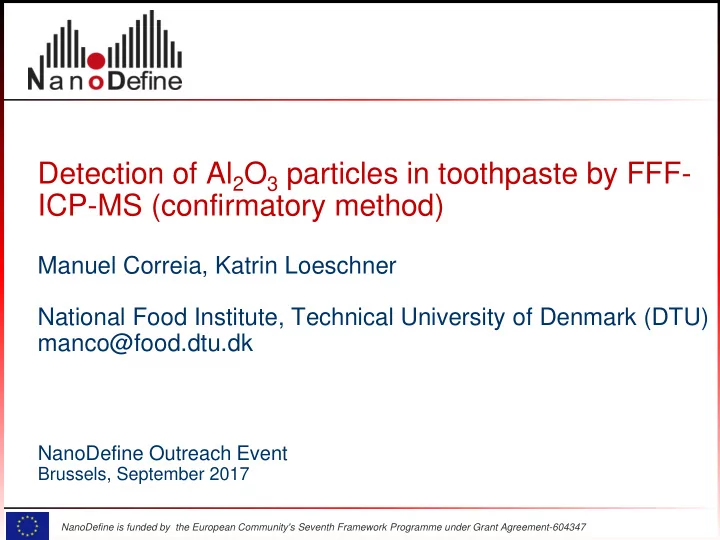

Detection of Al 2 O 3 particles in toothpaste by FFF- ICP-MS (confirmatory method) Manuel Correia, Katrin Loeschner National Food Institute, Technical University of Denmark (DTU) manco@food.dtu.dk NanoDefine Outreach Event Brussels, September 2017 NanoDefine is funded by the European Community's Seventh Framework Programme under Grant Agreement-604347
Background Why Al 2 O 3 particles in toothpaste? Relevant in terms of risk assessment and labelling for cosmetics Al 2 O 3 particles not widely covered in other projects Complex mixture containing different types of nano/micro-particles (e.g. SiO 2 , Al 2 O 3 ) Aims of the work: Develop a suitable sample preparation method for analyzing Al 2 O 3 in toothpaste by FFF-ICP-MS Develop the FFF-ICP-MS method and determine particle size and number concentration of Al 2 O 3 particles in toothpaste 2
Characteristics of the test toothpaste SiO 2 Al 2 O 3 TiO 2 (abrasive) (abrasive) (pigment) Ingredients: Aqua, Hydrated Silica, Sorbitol, Alumina, Olaflur, Hydroxyethylcellulose, Aroma, PEG-40 Hydrogenated Castor Oil, Stearic Acid, Sodium Saccharin, Cocamidopropyl Betaine, Citric Acid, Limonene, CI 77891, 3- (N-hexadecyl-N-2-hydroxiethylammonio)propyl-bis(2-hydroxiethyl)ammoniumdifluorid (1400 ppm F-) Al 2 O 3 TiO 2 SiO 2 19.7 ± 4.5 8.7 ± 0.6 238.4 ± 6.8 Concentration (mg/g, N=3) Crystall. phases Corundum Anatase - (XRD, BAM) Crystall. size 26 36 - (nm, XRD, BAM) Courtesy of BAM 3
Pre-characterization of the toothpaste DLS and zeta-potential TEM-EDX Zave = 267 nm Zeta pot: -42 mV Complex and polydisperse NP mixture Proper separation and identification of the different NPs is required → FFF -ICP-MS Toni Uusimäki, EAWAG 4
FFF-MALS/ICP-MS method development Sample preparation Tested on-line detectors Matrix dilution UV-vis absorption Chemical oxidation with H 2 O 2 Dynamic light scattering (DLS) Multi angle light scattering (MALS) AF4 separation parameters ICP-MS Carrier liquid (SDS, FL70, etc) ICP-MS required for element- Channel and membrane charact. specific information! Cross flow rate Focus/injection parameters Injected mass 5
Results: Sample preparation Matrix dilution vs Chemical oxidation with H 2 O 2 (MALS data) • Matrix dilution: unusual elution profile for and lower overall MALS signal • Chemical oxidation: ~60% recovery in comparison to flow injections (based on light scattering) → Chemical oxidation with selected as sample preparation procedure for analysis by FFF-MALS-ICP-MS 6
Results: AF4-MALS and AF4-ICP-MS Toothpaste after H 2 O 2 digestion, m inj = 10 µg ICPMS ( 27 Al) MALS • Three particles types (SiO 2 , Al 2 O 3 and TiO 2 ) contribute to the light scattering → elemental specific detection by ICP-MS is required 7
Results: FFF method development Optimization of FFF conditions (for optimal recovery and conversion to number distributions (noise level, removal of void peak) Carrier liquid composition Cross-flow optimization • Other parameters tested: membrane composition, carrier liquid (SDS, FL70, focus conditions), injection mass/volume 8
Results: FFF method performance Good reproducibility Linear response (6 different membranes) (5, 10, 25 µg inj. toothp.) • Method can provide reproducible AF4-ICP-MS fractograms for Al 2 O 3 • Drawback: low Al recoveries -15-20 % AF4-ICPMS recovery (losses to membrane, large particles) 9
Results: FFF method performance Conversion to number-based particle size distribution Number-based PSD Mass-based PSD Artifact Presence of artifact in mass-based PSD (no particles detected by sp- If log-normal fit is applied → d 50 = 155 nm, analysed Al 2 O 3 not consid. nanomaterial ICPMS after analysis of AF4 fractions → log-normal fit) 10
Summary and conclusions A FFF-ICP-MS method was sucessfully developed for • separating and analyzing unknown Al 2 O 3 particles in toothpaste Mass recoveries were not satisfactory in certain cases this • is difficult to avoid (loss of large particles) Secondary confirmatory method is required (e.g. artifacts) • → FFF -ICP-MS requires fine tuning for specific particle/matrix combinations 11
Thank you for your attention! New address since Easter 2017: Research Group for Nano-Bio DTU ´ s new building for Life Science & Science Bioengineering Toni Uusimäki “This project has received funding from the European Union’s Seventh Programme for research, technological development and demonstration under grant agreement No 604347”. 12
Recommend
More recommend